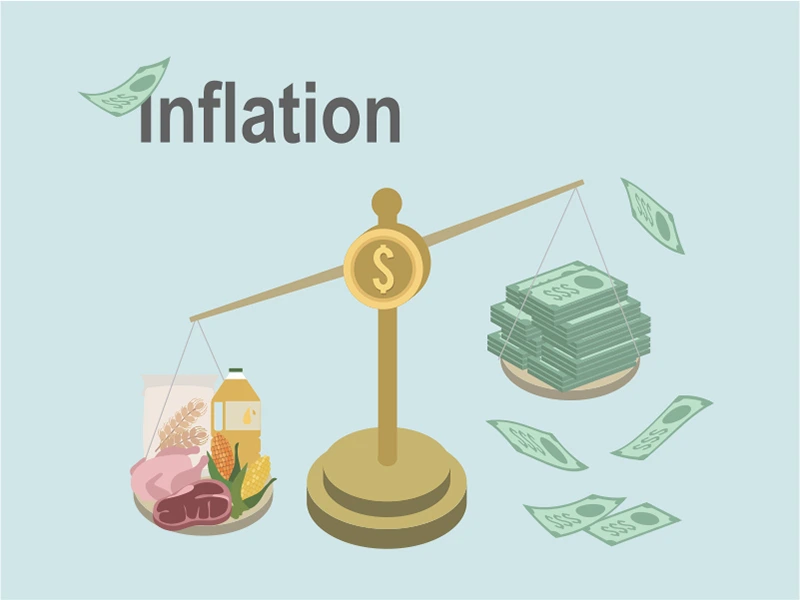Inflation’s impact on investment

Inflation’s impact on investment
Inflation impact on investment A rise in the typical price of goods and services over time is referred to as inflation. The Bureau of Labor Statistics, which gathers information to calculate the Consumer Price Index, measures it (CPI). The CPI measures the cost of items like petrol, food, clothes, and vehicles over time to determine how much the price of consumer goods and services has changed overall.
The cost of living, as determined by the CPI, increased by 7% in 2021. That indicates a 7% annual rise in costs overall. The CPI-measured increase in living expenses for the year ending in June 2022 was 9.1%. For instance, a vehicle that cost $20,000 in 2020 would now cost around $21,720.
Demand and supply are significant factors in inflation. Prices often increase when either supply or demand for an item or service changes. The pricing of commodities and labor, taxes on income and goods, and the accessibility of loans are just a few of the many factors that influence supply and demand on a national and worldwide level.
Rob Haworth, director of the investment strategy at U.S. Bank, states that “we’re still seeing challenges in the supply chain of numerous items as a result of economic shutdowns connected to the epidemic.” As a result, there are now imbalances and increased prices.
For instance, a lack of microchips has resulted in a sharp decline in the supply of new automobiles during the past year. As a result, there is an increase in demand for secondhand automobiles. Prices for both new and used automobiles have increased as a result of these factors.
Increasing inflation indicators
Interest rates and other monetary policies of the Federal Reserve (Fed): The Fed is now attempting to reduce inflation by boosting interest rates. Due to greater loan costs brought on by higher interest rates, firms may borrow less money and invest less. As a result, they may halt employment, which might lead to a reduction in consumer demand as income declines.
energy prices,, particularly for oil. Since oil is necessary for both the production and transportation of products, economic activity and oil demand are tightly intertwined. Oil prices have increased during the past year as a result of tighter supply as a result of Russia’s invasion of Ukraine, a recovery in economic activity, and rising demand. Future price increases in oil are anticipated to be restrained by a rebound in producer output as a result of rising demand.
Reduction in reliance on imported products and services, or rationalization The shift of manufacturing to other countries during the past ten years has centered on finding the manufacturer with the lowest cost. The cost of manufacturing, including the cost of commodities and labor, is anticipated to increase when manufacturers move back to the United States, leading to inflation. Future returns on all asset classes will be impacted by rising inflation. Investors should think about how potential effects could affect their investing plans.
When inflation is on the rise, assets with fixed, long-term cash flows often perform badly because their future cash flows’ buying power depreciates over time. On the other hand, commodities and investments with flexible cash flows, like rental income from real estate, generally fare better when inflation increases.
The impact of inflation on assets with fixed income
Investors often purchase fixed-income instruments like treasuries, CDs, and corporate or municipal bonds because they seek a steady income stream from interest payments. The buying power of interest payments, however, decreases when inflation rises since the interest rate on the majority of fixed-income assets stays the same until maturity. As a result, bond prices often decline in response to rising inflation.
The fact that most bonds have set interest or coupon payments is one factor. Rising inflation reduces the bond’s future (fixed) coupon income’s buying power, which lowers the bond’s future fixed cash flows’ current value. Given the cumulative effect of decreasing buying power for cash flows received in the far future, accelerating inflation is much more harmful to longer-term bonds.
Inflation’s impact on equities
The U.S. Bank Asset Management Group’s study shows that equities have outperformed the inflation rate over the past 30 years. Theoretically, a company’s earnings and sales should grow at a rate corresponding to inflation. As a result, the value of your stock should increase in line with the overall increase in the cost of consumer and producer items.
In the past 30 years, there has been a weak correlation between rising inflation and U.S. stock prices rising somewhat. Mid-sized businesses have historically had a greater association with inflation than smaller businesses, while larger businesses often have a stronger relationship than larger businesses. Prices of foreign equities in mature economies often declined when inflation increased, while prices of stocks in emerging nations showed an even greater inverse link.
Larger U.S. firm equities “may offer some advantage in circumstances with mildly rising inflation,” according to Haworth. However, in situations with higher rates of inflation, they are not the best investment strategy.
According to research done by the U.S. Bank Asset Management Group, real assets like commodities and real estate often have a positive link with inflation. Historically, investing in commodities has been a safe strategy to prepare for increasing inflation. The prices of goods and services, many of which directly involve commodities as well as closely connected things, are used to calculate inflation.
However, Haworth points out that those commodities have significant disadvantages. “They have historically underperformed stocks and bonds over longer periods, tend to be more volatile than other asset classes, and do not create any income.” When it comes to real estate, property owners frequently raise rent payments in response to rising product and service costs, which can result in increased earnings and investor payouts.
Why is the present inflation scenario in India a worry?
The Indian economy is now experiencing growing inflation. There are several causes behind it.
The entire economy has been impacted by COVID, which has disrupted global supply chains and output. Demand has suddenly increased as nations attempt to return to normal. Due to the Russia-Ukraine war, commodities prices, including crude oil, are rising.
Vegetables and other basic goods have seen their costs soar as a result of the surge in crude oil prices. As a result, the cost of LPG and petroleum products has also increased. With three consecutive months of inflation over the 6 percent threshold, India’s current inflation rate has reached a 17-month high of 6.95 percent.
According to the consumer price index, vegetables, oil, and fat, as well as meat and fish, have seen an increase in retail inflation. The RBI has increased its 2022–23 fiscal year inflation prediction from 4.5 percent to 5.7 percent.
The most effective way to beat inflation
When a difficult period is coming, investors get ready to protect their money. The best investing techniques during an inflationary period need a thorough analysis of all available possibilities. Equities have historically offered the strongest protection against increasing inflation. When a company’s product prices rise due to inflation, both its income and profit increase. Both the corporation and its investors benefit from this. Equity investments aid investors in long-term wealth accumulation and a rise in buying power.
Investments with set rates are the most stable, but in the circumstances like these, fixed-rate returns don’t increase fast enough to outpace inflation. A variable rate is therefore a preferable choice. Loans become more expensive when inflation rises, and the interest rate on variable rate bonds rises as well. By shifting their portfolio allocation toward floating-rate assets, investors can combat the negative consequences of inflation.
Commodity prices typically rise along with inflation in the economy. Several commodities, including gold, metals, real estate, some equities, and bonds, serve as excellent inflation hedges. Similarly to variable rate bonds, investing in consumer items might ease your inflation worries.
Investing in a turbulent market exposes you to more risk. Now is the moment to choose carefully. Keep to your investing strategy and the timeframe you have set. Investors should keep making continuous investments, especially if their time horizon is lengthy.
edited and proofread by nikita sharma





